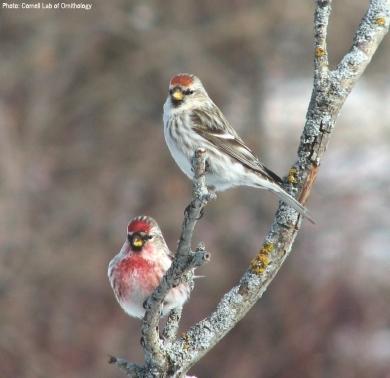Fun Facts About Redpolls
- As energetic as their electric zapping call notes would suggest, Common Redpolls are active foragers that travel in busy flocks. Look for them feeding on catkins in birch trees or visiting feeders in winter. These small finches of the arctic tundra and boreal forest migrate erratically, and they occasionally show up in large numbers as far south as the central U.S. During such irruption years, redpolls often congregate at bird feeders.
- Most people in North America get to see Common Redpolls only in the winter, when the birds come to feeders or forage on small seeds in trees or in weedy fields. Listen for their sharp, buzzy call notes and energetic trills and chatters
- Common Redpolls eat mainly small seeds, typically of trees such as birch, willow, alder, spruces, and pines, but also of grasses, sedges, and wildflowers such as buttercups and mustards, and occasional berries. During summer they also eat considerable numbers of spiders and insects. Winter diet is largely birch and alder seeds or, at feeders, millet and thistle or nyjer seed.
- Common Redpolls are energetic little birds that forage in flocks, gleaning, fluttering, or hanging upside down in the farthest tips of tree branches. Like many finches, they have an undulating, up-and-down pattern when they fly. Males court females but flying in slow circles while calling and singing. Males may feed females during courtship.
- You may see small flocks of this social species even during the breeding season; during migration they may group into the thousands. In winter, some redpolls roost in tunnels under the snow, where the snowpack provides insulation and stays much warmer than the night air.
- Females do most of the searching for nest sites. They place their nests over thin horizontal branches or crotches in spruces, alders, and willows. Nests tend to be low to the ground or, on the tundra, placed on driftwood, rock ledges, or other low ground cover.
- Common Redpolls can survive temperatures of –65 degrees Fahrenheit. A study in Alaska found Redpolls put on about 31 percent more plumage by weight in November than they did in July.
- The oldest known Common Redpoll was at least 7 years, 10 months old. It lived in Alaska and was injured when caught by a cat in 1990. Happily, it survived its injuries.


